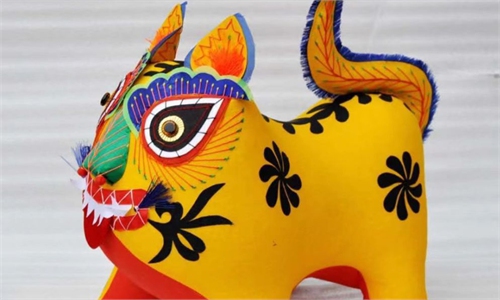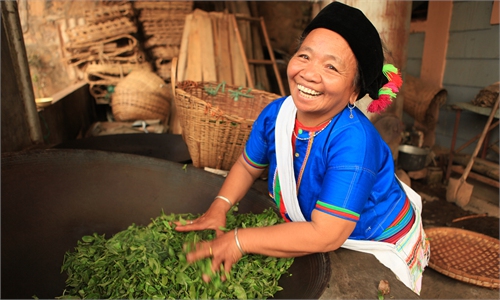ARTS / CULTURE & LEISURE
Why it took so long for tea to enter World Heritage List

Illustration: Chen Xia/Global Times
The successful inclusion of the Cultural Landscape of Old Tea Forests of Jingmai Mountain in Pu'er on the World Heritage List at the just-concluded 45th World Heritage Committee meeting is due to two important reasons. First, tea has had a significant impact on the development of human civilization. The trade of tea has facilitated international commerce, and the cultural aspects of tea have enriched the world. Moreover, certain major events related to tea have directly influenced modern human history. In 2019, the 74th session of the United Nations General Assembly designated May 21 as International Tea Day.
Second, the Jingmai Mountain possesses outstanding universal value and serves as an exceptional representative of numerous tea gardens and forests worldwide. It bears witness to the early traditional practice of understory tea cultivation, which effectively prevents pests and diseases through the utilization of forest ecosystems while providing nourishment for tea trees, thus achieving environmentally friendly agricultural production.
Traditional beliefs represented by ancestral tea worship, the tripartite system of traditional social governance involving government, tribes, and religion, the core knowledge system centered around understory planting and land use, and traditional tea culture all contribute to the millennium-old inheritance and vibrant vitality of the ancient tea forest.
Furthermore, the Old Tea Forests of Jingmai Mountain represents an outstanding model of sustainable land use based on horizontal and vertical land utilization, protecting both cultural and biological diversity. It is a precious example that embodies the challenging interaction between indigenous ethnic groups such as the Bulang and Dai and the impacts of modernization, urban development, and climate change. The simple ecological ethics of reverence and care for nature and the remarkable ecological wisdom of rational utilization and harmonious coexistence between humans and nature demonstrated by the ancient tea forests have positive implications for sustainable human development and the coexistence of diverse cultures.
In recent years, agricultural heritage has received significant attention due to its close connection with human production and livelihood. Currently, there are 34 World Heritage properties on the World Heritage List with agriculture as their main theme. Among them, there are already 18 cultural heritages related to economic crops, with the most being 12 sites associated with grape wine (such as the Lavaux Vineyard Terraces in Switzerland), three related to coffee (such as the Coffee Cultural Landscape of Colombia), and three related to other economic crops (such as the Agave Landscape and Ancient Industrial Facilities of Tequila in Mexico).
However, tea, which has the oldest cultivation and utilization history among the three major global beverages that includes grape wine and coffee, was just included on the World Heritage List. This is mainly related to the characteristics of tea itself.
Tea has an extremely long history of cultivation and is widely distributed geographically. The differences in natural and human geographical conditions in various regions have resulted in different tea varieties, cultivation methods, outward landscapes, and cultural connotations of tea gardens and forests, especially in terms of the relationship between humans and tea gardens or forests.
This poses challenges when conducting international comparative studies for heritage nomination. The World Heritage organization has attached great importance to this issue. In previous years, the International Council on Monuments and Sites (ICOMOS) organized thematic studies on Asian tea cultural landscapes and published in October 2021 a thematic study entitled Tea Landscapes of Asia. The Chinese cultural heritage authorities participated in this study and published in 2019 the ICOMOS Thematic Study on Tea Cultural Landscape - China. These research outcomes have laid a solid scientific foundation for the Cultural Landscape of Old Tea Forests of Jingmai Mountain in Pu'er to become the world's first tea cultural heritage site.
The world's tea cultures are diverse and profound. The successful inscription of the Cultural Landscape of Old Tea Forests of Jingmai Mountain in Pu'er is believed to have provided valuable references in terms of identifying heritage elements, elucidating heritage values, assessing authenticity and integrity, and establishing protection and management measures for other tea-themed heritage nominations.
The author is the director of Peking University's World Heritage Research Center.


